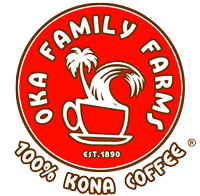Coffee History

Coffee was first brought to Hawaii in 1825 by physician Don Francisco de Paula y Marin of Jerez de la Frontera, Spain. The coffee plant was brought to the Kona district in 1828 by Samuel Reverend Ruggles from Brazilian cuttings.
In other parts of the Hawaiian Islands, coffee was grown on large plantations, but the 1899 world coffee market crash caused plantation owners to lease land to their workers. Japanese immigrants were brought to work on sugar plantations and were the ones to purchase three to five acre parcels that were sold for $30 a year.
The tradition of family farms continued throughout Kona. The Japanese-origin families have been joined by Filipinos, mainland Americans, and Europeans. There are approximately 800 Kona coffee farms, with an average size of less than 5 acres. In 1997 the total Kona coffee area was 2,290 acres and green coffee production just over two million pounds.
It was the sunny mornings, mild afternoons, the elevation and steady Pacific breezes of Kona combined with the mineral-rich volcanic soil of Hualalai Mountain, that was the perfect combination for growing Coffea Arabica trees.
This combination creates for a uniquely rich and flavorful taste of KONA COFFEE. Coffea Arabica is the one that is probably the best known variety, on which more than 75% of the world's commerce relies. Arabica coffee beans are sweet and highly flavored. It is well known that after being roasted, coffee beans need to be immediately packed or preserved in special conditions so that the aroma doesn't fade away. Arabica is more expensive to produce and harvest than most other varieties.
More coffee 101!

First of all, did you know coffee beans are not actually beans, but the seed of a cherry from a coffee tree? These trees two in subtropical climates from sea level to around 6000 feet.
Harvesting Coffee Beans:

Coffee is a very labor intensive commodity. The cherries ripen at different times so they must be picked by hand. Since there are about 4000 coffee beans in a pound, 2000 cherries must be hand picked (there are two beans per cherry unless it's peaberry). The average coffee tree will priduce only about 2 pounds of roasted coffee per year.
Next, the fruit of the cherry needs to be removed from the seeds. This is accomplished by either 2 ways, the dry process or the wet process. The dry process is to let the cherries dry out in the sun or in dryers and then use machines to strop the dried fruit off the coffee beans.
The wet process uses a soaking method to make the fruit come off and produces coffee which is referred to as washed coffee.
These green coffee beans are then sent to be dried. After drying, they are sorted by size and graded (usually by hand). Then they are bagged and sent to the roasters. The beans will remain green until roasted.
It is important to note that green coffee will stay fresh for a very long time. When freshness is talked about in coffee, it means from date that the green beans have been roasted.
Now that you know a little about the process, there are 2 species of coffee.
About robusta and arabica coffee
Robusta coffee is a lower grade of coffee that is typically grown at lower elevations. It has more of a astringent flavor and contains a higher amount of caffeine.
The robusta trees are easier to grow and maintain. They are also more disease resistant and produce a higher yield. This type of coffee is typically used to achieve a lower price.
Arabica coffee is the superior grade of coffee that most people usually refer to as gourmet coffee. They contain about half of the caffeine of robust and have more desirable flavors and aromatic properties. Much of the coffee grown world wide is of the arabica species, but only a fraction meets standard set by the Specialty Coffee Association of America.
Production on Oka Family Farms have been over 100 years. We are proud to be a part of the production from year round care of the trees, harvesting the beans, all the way to roasting and packaging. We hope you enjoy our special family tradition.
